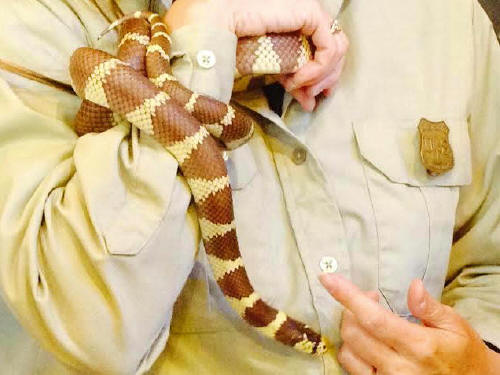 California kingsnake
California kingsnake
Lampropeltis getula californiae / Family: Colubridae
This native species is non venomous, finds its home in the San Gabriel Mountains, and is widespread throughout the Southwest U.S. It's called "king" because it is at the top of the food chain within the local snake world and will hunt and consume other snakes, including venomous rattlesnakes. California kingsnakes are opportunistic feeders and will eat virtually any vertebrate they can constrict, including birds, rodents, amphibians, and other reptiles.
The California kingsnake is active both in the day (diurnal) and night (nocturnal), but tend toward nocturnal behavior if the weather is too hot. They usually hibernate (brumation) in the winter.
They lay eggs as opposed to giving live birth like some other snakes. The clutch size is generally five to twelve eggs and the eggs usually hatch in late summer or early fall. Hatchlings are about 12 inches long. Adult kingsnakes are most commonly found to be 2.5 to 3.5 feet in length. (Sources: See California Kingsnakes Links below)
I don't recall ever seeing a California kingsnake in the wild, so I'm still looking.

California kingsnake at Chilao Visitor Center, Angeles National Forest
Photo by Samantha Moench, April 5, 2014
California Kingsnake Links:
Other Snakes in the San Gabriels:
- Southern Pacific rattlesnake (Crotalus oreganus [Old: viridis] helleri)
- Gopher snake (Pituophis catenifer)
- Striped racer (Masticophis lateralis)
- Two-striped garter snake (Thamnophis hammondii)
 Animals in the San Gabriel Mountains
Animals in the San Gabriel Mountains
 Plants in the San Gabriel Mountains
Plants in the San Gabriel Mountains
|